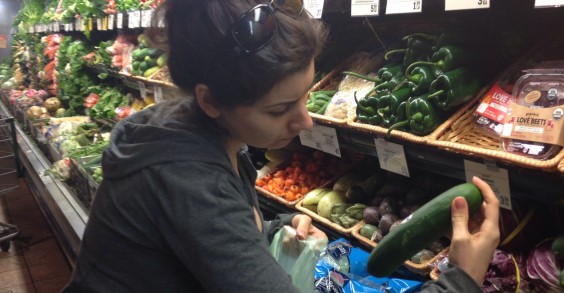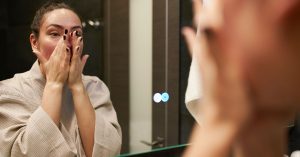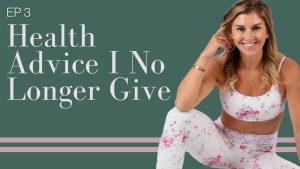Why Going Organic Was the Most Expensive, Frustrating, and Worthwhile Thing I’ve Ever Done for My Health
From 2013 to 2014, my life imploded. After 25 years of being totally healthy, I was diagnosed with three major medical conditions out of nowhere. While in recovery from two brain surgeries—one for a congenital blood vessel abnormality and the other for a cerebrospinal fluid disorder that my doctors think developed as a result of the first—I learned I have a rare, incurable autoimmune disease that attacks the joints of the spine and causes terrible back pain. I was losing my health, close to losing my sanity, and everything besides merely staying alive had to be put on hold, including my career, relationships, and hobbies. After being offered a medication that can have devastating side effects, such as cancer and sudden death (no big deal, right?) to control my

From 2013 to 2014, my life imploded. After 25 years of being totally healthy, I was diagnosed with three major medical conditions out of nowhere. While in recovery from two brain surgeries—one for a congenital blood vessel abnormality and the other for a cerebrospinal fluid disorder that my doctors think developed as a result of the first—I learned I have a rare, incurable autoimmune disease that attacks the joints of the spine and causes terrible back pain. I was losing my health, close to losing my sanity, and everything besides merely staying alive had to be put on hold, including my career, relationships, and hobbies.
After being offered a medication that can have devastating side effects, such as cancer and sudden death (no big deal, right?) to control my autoimmune disease, I sought out another opinion from Elizabeth Boham, M.D., who practices something called functional medicine at the UltraWellness Center in Lenox, MA. Having seen Boham on the Dr. Oz Show and then reading about her work online, I was drawn to her emphasis on looking at the body as a whole, integrated system to uncover the underlying causes of dysfunction. My body seemed to be falling apart, but my doctors insisted that one condition had nothing to do with another—they saw each part of my body as separate.
 Boham had survived breast cancer herself at age 30, so she knew what it felt like to be young and sick, and understood the challenges of navigating the healthcare system, which I was having so much trouble with. Something inside of me just clicked—I had to meet her.
Boham had survived breast cancer herself at age 30, so she knew what it felt like to be young and sick, and understood the challenges of navigating the healthcare system, which I was having so much trouble with. Something inside of me just clicked—I had to meet her.
WTF Is Functional Medicine, Anyway?
Functional medicine is a fairly new field of medicine that uses diet modifications, supplementation, and stress reduction (sometimes in conjunction with medications) to address disease. Most insurance companies don’t cover functional medicine, so I shelled out a pretty penny (four months’ rent, to be exact) for my appointment as well as dozens of tests, including saliva, urine, blood, stool, and hair samples.
After looking at the results, in a follow-up appointment, Boham said that autoimmune disease is usually triggered by a bacterial infection of some sort, oftentimes in the gut, and I had multiple strains of harmful bacteria in mine. (High levels of bad bacteria in the intestines is one of the suspected causes of inflammatory autoimmune disease now recognized by the National Institutes of Health.) So she recommended completely overhauling my diet since food makes a major impact on the health of our gut flora.
Learning to nourish myself properly felt like the best gift I could give myself.
Desperate to heal and hoping to avoid heavy-duty medications, I decided to go all-in on this experiment. Western medicine wasn’t offering me anything other than an Rx to keep symptoms at bay, but what I wanted and needed was healing. I told myself that if I didn’t try to correct the deeper imbalances that brought on this disease, I might suffer from even bigger problems down the road. Plus, learning to nourish myself properly felt like the best gift I could give myself—I’ve always believed that diet has a big impact on health, but I never had the time to put much thought into mine—and if there was even a sliver of a chance this could help ease my chronic pain, it was worth a shot before going whole hog on a dangerous medication for the rest of my life.
Organic or Broke (Literally)
Some studies show there’s no real difference between conventional and organic produce in terms of nutrient content, but according to a 2014 meta-analysis published in the British Journal of Nutrition organic food has higher concentrations of antioxidants and lower toxic pesticide residues—and Boham said that organic food would offer me more health benefits 1 .
So my “prescription” was to eat as much organic as I could afford, and to cut out gluten and dairy, both of which can promote inflammation in the body. I also had to stop relying on processed foods and almost anything sold in a package, meaning I’d need to cook most of my meals. Any meats and fish had to be grass-fed, antibiotic-free, and wild-caught as much as possible, because whatever the animal is exposed to, you eat, Boham said. And research has shown that growth hormones and antibiotics in meat and PCBs in farm-raised fish may harm our health in various ways, including impacting reproductive health and raising the risk for some cancers 2 .
 To say this required a major lifestyle change is an understatement. On my first trip to the grocery store, my bill was close to $300. And that didn’t even last a week—I often shopped two or three times weekly to prevent my produce from going bad.
To say this required a major lifestyle change is an understatement. On my first trip to the grocery store, my bill was close to $300. And that didn’t even last a week—I often shopped two or three times weekly to prevent my produce from going bad.
My income wasn’t high enough to afford the added expense, so I more than dipped into my savings: I blew through them. As my friends were going on vacations and having fancy dinners out, I was shelling out any money I’d normally use on fun at Whole Foods or Trader Joe’s. And then I’d come home and spend two or more hours every day planning, prepping, and cooking—rather than working, so my job as a freelance writer and editor started to suffer.
When I did dine out, my restricted diet sucked almost every ounce of fun out of the experience. I was always the most high-maintenance eater in the room, turning ordering at a restaurant into an Olympic endeavor. I ticked off more than a few waitresses rattling off questions—“Is the broccoli organic?” “Is this grass-fed beef?”—that sent them running to the kitchen to interrogate the chef. While my boyfriend didn’t mind the extra 20 minutes it took me to order, others, like my mom, thought the whole thing was ridiculous and tried to get me to order a cheeseburger.
The idea of going into debt didn’t feel as scary as the thought of being chronically ill the rest of my life.
I quickly learned that most restaurants don’t have organic menus, so I started to bring my own pre-cooked food in containers everywhere I went. (Totally normal, right?) But on several occasions, I didn’t have time or forgot, so I was stuck somewhere with no “allowed” food available—and I went hungry, got low blood sugar, and felt dizzy and sick.
Another time, the check I sent to pay my health insurance bounced because I had accidentally spent the money on groceries. And one day, upon realizing I was going to miss a work deadline, I broke down in tears on my kitchen floor while blanching collard greens and sautéing ground turkey. And then I got back up and returned to the stove, ignoring work.
I didn’t know how much longer I could manage this lifestyle, but I ignored my fears (and thoughts that I was more than a little insane) and kept moving. I wanted to believe this would work—and the idea of going into debt didn’t feel as scary as the thought of being chronically ill the rest of my life.
It’s Working… Sort Of
Sacrifices and mental health notwithstanding, I did start to feel physically better pretty quickly. Within a few weeks, I noticed I had more energy, less acne, and fewer sugar cravings, though those weren’t the complaints that brought me to this diet.
I also began to really appreciate and savor the food on my plate, for perhaps the first time in my life. I didn’t grow up eating sit-down dinners with my family, and once I entered the workforce I never seemed to have time to prepare a real dinner. At last, I felt like I was getting to do something I had missed out on my whole life.
My bloodwork pointed to some improvements too: At the beginning, my iron, magnesium, calcium, and vitamin D levels were all in the tank, and I was prediabetic, meaning my hemoglobin a1c level—the measure of how much sugar is in your blood over a three-month span of time—was creeping up. After three months of my new diet, all of my blood levels went back to normal, and I was no longer prediabetic. The nurse who reviewed my results with me remarked about how unusual it is not to have a single value out of range.
At the four-month mark, Boham did some more stool testing and found that the balance of flora in my gut was much healthier too. All but one of my infections had cleared, and my digestion reflected that: No more bloating or gas, better digestion, and easy poops every morning like clockwork. It made sense: I had given up sugar and refined carbohydrates, which bad bacteria feed on, and started eating more prebiotic and probiotic foods, such as asparagus, garlic, leeks, and sauerkraut, which good bacteria need in order to grow. I felt so proud of myself for sticking to it.
The bad news: At that same time, my joint pain and swelling weren’t getting any better, and I was having so much trouble walking that my rheumatologist feared I was doing permanent damage to my joints by holding off on medication. So I started taking a drug to control my autoimmune-related chronic pain, and it put me into remission within one month. (Western medicine, for its drawbacks, is pretty amazing when it works.)
My Personal Prescription: Moderation
While my autoimmune disease can’t be managed with diet alone, I rest easy knowing my improved diet is keeping the rest of me healthy—and maybe keeping some of the ill effects of my medicine at bay (I can only hope). Plus, in a few months I may try coming off the medicine to see where I stand now that my gut is healthier.
Would I do this very costly, totally enlightening, and frequently maddening experiment again? Yes.
Would I do this very costly, totally enlightening, and frequently maddening experiment again? Yes. It made me a smarter consumer, a better eater, and quite a talented cook. I know multitudes more about the healing properties of food, how to feed myself, and what I need to do in order to stay as healthy as I possibly can in spite of my health issues. I have peace of mind knowing that I tried virtually everything in search of a natural cure-all, but ultimately, a balance of modern and functional medicine is the magic elixir that’s giving me the best shot at a good quality of life. And the time and money investment was healing in and of itself, because it was an act of self-love.
Still, I became more lax at the one-year mark, allowing some takeout and refined treats on occasion, because I just. couldn’t. do. it. anymore. I buy about half organic and half conventional food now, and rely on some pre-cooked meats and pre-packaged salads and snacks, but I’m still gluten-, dairy-, and sugar-free (save a square of 85-percent dark chocolate in the afternoon).
While I know it’s valuable to continue to use the dietary knowledge I’ve gained, I also recognize the importance of keeping my mental, emotional, and financial health a priority—which means not allowing my diet to isolate me from friends or put me in the poorhouse, and not planning my day solely around my meals. Health means more than just eating healthy food. Now I’m trying to live with everything in moderation.
Works Cited
- Are organic foods safer or healthier than conventional alternatives?: a systematic review. Smith-Spangler C, Brandeau ML, Hunter GE. Annals of internal medicine, 2012, Nov.;157(5):1539-3704.
Higher antioxidant and lower cadmium concentrations and lower incidence of pesticide residues in organically grown crops: a systematic literature review and meta-analyses. Barański M, Srednicka-Tober D, Volakakis N. The British journal of nutrition, 2014, Jun.;112(5):1475-2662. - Effect of occupational polychlorinated biphenyls exposure on quality-adjusted life years over time at the HELPcB surveillance program. Esser A, Gaum PM, Schettgen T. Journal of toxicology and environmental health. Part A, 2015, Jan.;78(2):1528-7394.
Case-control study of breast cancer and exposure to synthetic environmental chemicals among Alaska Native women. Holmes AK, Koller KR, Kieszak SM. International journal of circumpolar health, 2014, Nov.;73():2242-3982.
Persistent organic pollutants in young adults and changes in glucose related metabolism over a 23-year follow-up. Suarez-Lopez JR, Lee DH, Porta M. Environmental research, 2015, Feb.;137():1096-0953.
SOURCE: Greatist RSS – Read entire story here.








